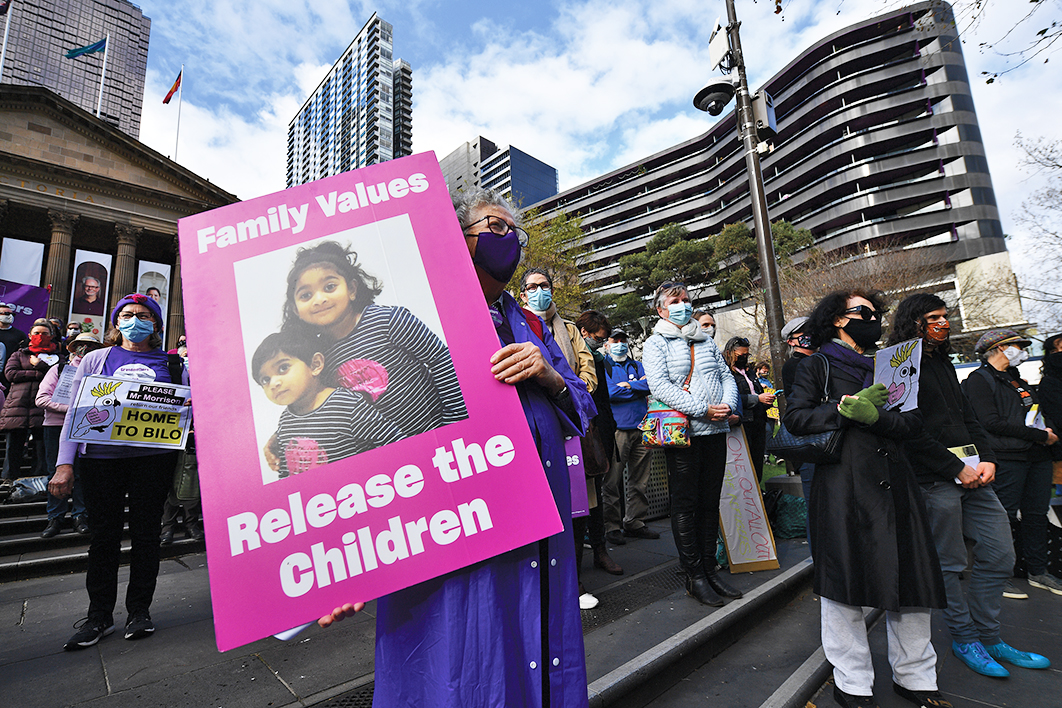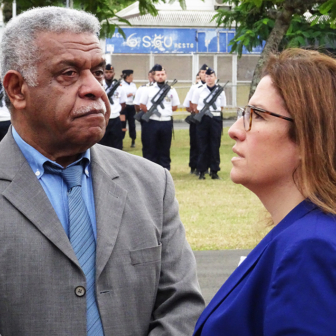In March 2020, as Covid-19’s global spread accelerated, the federal government took unprecedented steps to reduce arrivals in Australia to a tightly controlled trickle. Many of us found ourselves unable for the first time to travel relatively freely — a freedom we enjoy because of the privileged passport we hold. Australia ranks ninth on the Henley Passport Index, meaning our passport holders have access to 185 countries without having to obtain a visa in advance. Afghanistan ranks last, with its passport holders able to enter just twenty-six countries without a prior visa.
Despite coming from a nation that prides itself on hard borders, many Australians have experienced the world as a porous and relatively borderless place. Until eighteen months ago, it was unfathomable that Australian citizens and permanent residents would be prevented from re-entering their own country. Or, indeed, that we would be prohibited from leaving it. Still more unthinkable was the idea of hard borders between states and territories.
For the many people whose families, lives and livelihoods crisscross internal and international borders, these new obstacles offer a glimpse of the experience of those who flee persecution or serious harm in their home countries and are blocked from reaching safety by administrative and legal barriers — barriers that can seem unfair, opaque, arbitrary, ever-changing and unresponsive to personal circumstances.
If we hadn’t realised it before, we now know that borders aren’t physical or geographic. They are legal and administrative constructs, created and controlled by governments. We also know that border closures don’t always benefit those for whom they are purportedly enacted.
As we have already seen this year in Myanmar, Hong Kong and now Afghanistan, conflict and persecution continue to shape patterns of movement in our region, just as Covid-19 has. So too, increasingly, will a changing climate and related disasters. To set our border policies as if these are not Australia’s problems, and can be pushed back indefinitely, is short-sighted and dangerous.
Somehow, we need to start preparing public sentiment for the introduction of more appropriate policies. The Covid-19 pandemic may provide the opportunity to do so.
For many Australians, the coincidence of disturbing footage from Afghanistan and the twenty-year anniversary of the “Tampa affair” has been particularly unsettling. It was back then, in August 2001, that the Howard government began building the most draconian asylum policy yet seen in Australia. Parts of our territory were “excised” from the migration zone to prevent people from claiming asylum; offshore processing was introduced; and the military was given new orders to intercept and turn back boats.
Since then, Australia has pushed back boats with little regard for the circumstances to which the people on board are returned. We have left people to languish in Nauru and Papua New Guinea until they disintegrate physically and mentally. We have detained people in prison-like conditions in Australia, despite the availability of less restrictive alternatives. And the “lucky” ones — those who are recognised as refugees and permitted to live in the Australian community — have been condemned to a life of rolling temporary visas shown to cause and exacerbate anxiety, depression and post-traumatic stress disorder, particularly in children.
This physical and psychological harm has been meticulously documented by private contractors, doctors and trauma counsellors. It has been noted with growing alarm by every independent human rights body to review Australian asylum practice. It has even been referred to the International Criminal Court — six times since 2014 — as amounting to crimes against humanity.
Increasingly, though, ordinary people are horrified, or at least discomforted, by where Tampa politics have led us. Nowhere is this more evident than in the national groundswell of support for the Murugappan family, driven by an unlikely source: the rural Queensland town of Biloela, where the family members lived until they were ripped from their home in a dawn raid.
The Murugappans’ young girls, both born in Australia but deemed “unlawful non-citizens” once their mother’s visa lapsed, have since grown up in detention. The youngest, Tharnicaa, was just eight months old when she was first detained. By the time she was two, four of her teeth were rotten and required surgical removal, apparently because of a lack of fresh food and sunlight in detention. Shortly before her fourth birthday, she was again rushed to hospital, this time with a suspected life-threatening infection. Many Australians, even those who have reservations about immigration, were disturbed by images of this child crying on a hospital bed as her older sister Kopika, herself just six, tried to comfort her.
As the support for the Murugappans makes clear, it is not a matter of “left” versus “right,” “idealists” versus “pragmatists,” or supporters versus opponents of refugees. Good people across the political spectrum and from all walks of life are speaking out about how Australia’s treatment of vulnerable people offends their sense of decency.
But the political space for reasoned debate on refugee protection has all but vanished. Battle lines have been drawn and the topic remains bitterly divisive. For many years, the outlook for a more humane approach has been bleak.
Or at least it was until Covid-19. The pandemic is the most significant global disruption to occur since the seismic political and social shifts that followed the terrorist attacks of 11 September 2001. Just as those shifts shaped Australia’s handling of the Tampa affair and its aftermath, this pandemic may provide an opportunity to shape how we will approach asylum issues in the future.
In an election speech a few weeks after Tampa, John Howard delivered the refrain that has haunted Australian asylum policy for decades: “We will decide who comes to this country and the circumstances in which they come.” It was bold, powerful, and yet untrue. Prior to the pandemic, no country had ever been able to totally control who arrived at its borders, or their mode of travel. But facts are not where the power of Howard’s statement lay. It lay in the concept — sold to and readily accepted by many — that our border needed to be “protected” and “defended” with an iron fist rather than simply managed in an orderly and humane way.
By using wartime language, enmeshing asylum policy with national security, and singling out asylum seekers arriving by boat, this approach framed maritime migration as a threat to be feared. It gave a false impression that there are two categories of non-citizens entering Australia: those who enter at airports and seaports with correct documentation and, by reason of having “done the right thing” administratively, pose no inherent national security threat; and those who arrive by boat without prior approval and without the proper paperwork.
Is this distinction accurate? Before 2020, thousands of people flew in and out of Australia every day with little or no active government decision-making. They did so because they were fortunate enough to hold the right passport. With eGates and other new technology, some may have entered and left Australia without a single word to a border official. The government would have no record of their background and circumstances, why they were here, or what they did during their stay.
By contrast, asylum seekers arriving in Australia by boat are among the most closely vetted groups of non-citizens. In the words of Malcolm Turnbull, “We know exactly everything about them.” We scour their backgrounds and plumb the depths of their traumas as they undergo rigorous screening and refugee status processes. As they await decisions on their claims, almost every aspect of their lives is monitored and controlled by the government.
Where the individuals themselves can’t be found to pose a threat, attention shifts to the risk that would arise if “everyone” came. This fear of invading masses goes back a century or more, but in the past twenty years it has become accepted as truth, even by moderates and progressives. Across the political spectrum, there is a shared view that steps must be taken to deter people from making their own way to safety in Australia.
The reality is much more complex. Almost 60 per cent of the 82.4 million people displaced in 2020 remained within their own countries. Most of the rest are unlikely ever to end up on a boat to Australia, regardless of our policies, because we are too far away or they have already found a safe haven. The overwhelming majority of refugees stay close to home, in neighbouring countries and among other displaced compatriots.
For those who do seek safety further abroad, the risks inherent in being smugg-led across the sea are a powerful deterrent. And if they do reach Australian soil, they face a rigorous legal process to determine whether they meet the strict criteria for protection. The idea that deterrent policies are the only thing holding millions of people at bay doesn’t match the reality of displacement.
Nor does the humanitarian trump card that offshore processing has “saved lives at sea.” Cruel policies are justified as necessary to prevent people from getting on boats and potentially drowning, but there is little evidentiary basis for this defence. We know that offshore detention, for example, didn’t stop boats or save lives. Boat turnbacks may reduce drownings, but only to expose people to risks of death and serious harm elsewhere. The militant secrecy surrounding these operations makes it impossible to assess the full extent of the dangers to which people are returned, but we do know that people have been turned back only to face persecution and flee again.
Finally, drownings can’t be attributed only to the treachery of the sea and smugglers. Some governments delay complying with their obligations to render assistance to people in distress at sea in an attempt to avoid responsibility for looking after rescued asylum seekers. Journalist David Marr recently described how Australia did just that with the Palapa 1 (the passengers of which were rescued by the Tampa), with potentially fatal consequences. Australian navy officers have described to the ABC how unseaworthy asylum seeker vessels were left to founder because of pressure from Canberra. One incident resulted in “a line about seventy miles long of bodies” in the sea. Yet we rarely hear about the role Australian government decision-making plays in exacerbating the risks of maritime migration.
We don’t need to find new and workable “solutions” to the problem of boat arrivals. We need to dislodge boats from the centre of the debate and neutralise their political potency.
The best way to stop people from travelling via dangerous routes is to establish safe and legal pathways. Sufficiently large and targeted resettlement programs, together with generous support for the countries hosting large numbers of refugees in affected regions are the most effective ways to reduce the number of people risking their lives in search of safety.
Australia could establish protected entry procedures and expand the processing capacity of Australian officials abroad. And we could implement simpler meas-ures immediately. As Peter Mares wrote recently online in Inside Story, “border protection proceeds bureaucratically and out of sight.” Many people are denied visas if officials suspect they might apply for asylum after arriving in Australia. If that criterion had been removed, at-risk Afghan students and workers might have been able to fly safely into Australia long ago, rather than being caught in the chaos and violence engulfing Kabul airport and the rest of the country.
Even then, people might still arrive at the Australian border, by sea or by air, without seeking prior approval. So long as such arrivals are not spun for political gain, Australia could — with strong leadership — manage them in an orderly and humane way. We have the capacity to process large numbers of people fairly and efficiently, and to settle anyone entitled to protection. If arrivals by sea or air did happen to spike temporarily and put pressure on the system, assistance could be sought from other governments and global agencies.
Rather than punishing people already in Australia, we might audit existing asylum policies to see where changes need to be made. Critically, this would need to be an agile system, strengthened by its flexibility in the face of emerging challenges and ever-shifting international dynamics.
These suggestions may seem radical, but as the Kaldor Centre Principles for Australian Refugee Policy demonstrates, a renewed commitment to our international legal obligations would both improve Australia’s reputation as a good international citizen and a leader in human rights, and provide a stronger basis for cooperation between Australia and other countries on refugee protection issues, within the Asia-Pacific region and globally. Such an approach is feasible, and could be modelled on good practice from abroad and Australia’s own past experience. It is also in the national interest. Human mobility and displacement are realities that we should be able to manage in a sustainable way.
Other lessons can be drawn from the pandemic. Many millions of Australians have experienced hard lockdowns and are likely to have a newfound appreciation for the value of liberty. While some returned travellers lamented fourteen-day stays in relatively well-appointed hotel quarantine facilities, sick refugees were held for more than a year in close quarters in hotels and motels that weren’t designed for this purpose. In fact, Australia broke with international trends by increasing its immigration detention population by nearly 12 per cent in the first six months of pandemic.
Australians have also been separated from family members and friends abroad or interstate, or indeed in the same city, for indeterminate periods, not unlike the refugees who make it to Australia only to be told they will never be able to bring their spouses, children, siblings or parents to join them.
And the indiscriminate nature of Covid-19 is a reminder that we are all in this together. The wellbeing of our society as a whole depends on that of each individual member and group. Viruses do not differentiate on the basis of immigration status or background, and developments elsewhere — particularly new Covid-19 variants — can directly affect daily life here. Our reinforced interconnectedness reveals that isolationist tendencies are no longer appropriate or sustainable, if ever they were. Unfortunately, recent statements from the prime minister and his ministers indicate that they have no interest in using these pandemic lessons to rethink Australia’s refugee policies. While the internet was awash with frantic scenes from Kabul airport, we saw Scott Morrison admonishing Afghans who didn’t come to Australia “the right way” and sending “a very clear message to people smugglers in the region that nothing has changed.”
Until our leaders are ready to catch up, the rest of Australia might consider slowly, tentatively, starting to unpick the Tampa’s legacy and chart a better way forward. If managed properly, this “once-in-a-lifetime” pandemic could offer a once-in-a-lifetime opportunity for a new approach to refugee policy — one that is not only more humane and just, but also more orderly and sustainable as we tackle the challenges of a post-pandemic world. •




